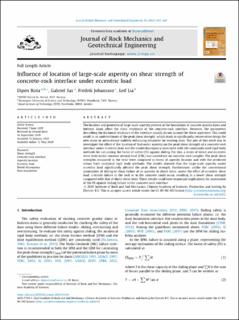Influence of location of large-scale asperity on shear strength of concrete-rock interface under eccentric load
Journal article
Published version
Permanent lenke
https://hdl.handle.net/11250/2738526Utgivelsesdato
2020Metadata
Vis full innførselSamlinger
Sammendrag
The location and geometry of large-scale asperity present at the foundation of concrete gravity dams and buttress dams affect the shear resistance of the concrete-rock interface. However, the parameters describing the frictional resistance of the interface usually do not account for these asperities. This could result in an underestimate of the peak shear strength, which leads to significantly conservative design for new dams or unnecessary stability enhancing measures for existing ones. The aim of this work was to investigate the effect of the location of first-order asperity on the peak shear strength of a concrete-rock interface under eccentric load and the model discrepancy associated with the commonly used rigid body methods for calculating the factor of safety (FS) against sliding. For this, a series of direct and eccentric shear tests under constant normal load (CNL) was carried out on concrete-rock samples. The peak shear strengths measured in the tests were compared in terms of asperity location and with the predicted values from analytical rigid body methods. The results showed that the large-scale asperity under eccentric load significantly affected the peak shear strength. Furthermore, unlike the conventional assumption of sliding or shear failure of an asperity in direct shear, under the effect of eccentric shear load, a tensile failure in the rock or in the concrete could occur, resulting in a lower shear strength compared with that of direct shear tests. These results could have important implications for assessment of the FS against sliding failure in the concrete-rock interface.

